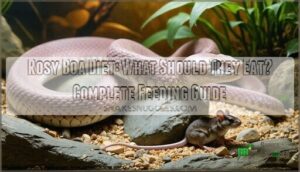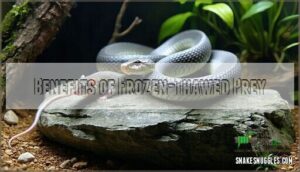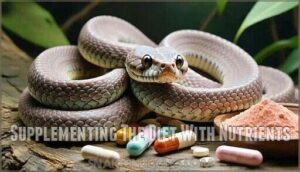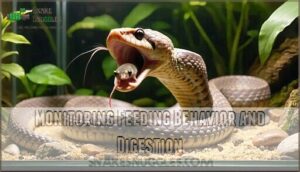This site is supported by our readers. We may earn a commission, at no cost to you, if you purchase through links.
 Your rosy boa’s diet should consist primarily of appropriately-sized frozen-thawed mice or rats.
Your rosy boa’s diet should consist primarily of appropriately-sized frozen-thawed mice or rats.
Feed adults every 7-10 days and juveniles every 5-7 days. The prey should match your snake’s thickest body section – roughly 10% of their total weight.
Hatchlings start with pinkies, graduating to hoppers and eventually adult mice as they grow.
Skip live prey since it can injure your snake through scratches or bites. Frozen-thawed rodents are safer and equally nutritious.
Don’t panic if your rosy boa takes forever to finish eating – they’re naturally slow diners who savor their meals. Proper sizing and timing make all the difference in keeping your snake healthy and preventing feeding issues.
Table Of Contents
- Key Takeaways
- Rosy Boa Diet Basics
- Feeding Frozen-Thawed Rodents
- Choosing The Right Prey Size for Your Rosy Boa
- Supplementing The Diet With Nutrients
- Monitoring Feeding Behavior and Digestion
- Common Dietary Issues and Concerns
- Seeking Veterinary Care for Dietary Issues
- Frequently Asked Questions (FAQs)
- What do rosy Boas eat?
- Can rosy Boas eat mice?
- How do you feed a rosy boa in captivity?
- What is rosy boa care?
- How often should you feed rosy Boas?
- Can rosy Boas eat frogs?
- How often should I feed my baby Rosy Boa?
- Do rosy boas need a water dish?
- How often should I clean my Rosy Boa tank?
- How often should I feed my Rosy Boa?
- Conclusion
Key Takeaways
- Feed frozen-thawed rodents only – You’ll avoid injury risks while providing complete nutrition, with prey matching your snake’s widest body section (roughly 10% of their weight)
- Adjust feeding frequency by age – You should feed juveniles every 5-7 days and adults every 7-10 days, reducing frequency during cooler months when metabolism slows
- Size prey properly to prevent problems – You’ll start hatchlings on pinkies, progress to hoppers, then adult mice as they grow, avoiding oversized meals that cause regurgitation
- Monitor feeding behavior and health – You can expect slow eating (it’s normal), but watch for persistent refusal, weight changes, or digestive issues that might require veterinary care
Rosy Boa Diet Basics
Feeding your rosy boa properly starts with understanding three key elements: the right prey items, appropriate feeding frequency, and correct food size.
Getting these basics right guarantees your snake stays healthy and grows at a steady pace throughout its life, which is crucial for its overall well-being and development.
Prey Items
In regards to your rosy boa diet, understanding prey items is essential for proper nutrition.
In the wild, rosy boas hunt deer mice, kangaroo rats, and small mammals through ambush predation.
For captive boas, you’ll choose between live feeding and frozen options. Live prey stimulates natural hunting instincts but carries injury risks.
Frozen mice offer safer prey variety while maintaining nutritional value. Most keepers prefer frozen-thawed fuzzy mice and adult mice as reliable boa prey.
A suitable prey size matches snake’s body width at its widest point. Supplementation isn’t typically needed with whole prey items, making frozen options both convenient and complete.
Feeding Frequency
Establish a consistent feeding frequency that matches your rosy boa’s age and activity levels.
Your snake’s feeding schedule directly impacts their health, growth, and overall well-being throughout different life stages.
Here’s how feeding frequency varies by age:
- Juvenile Frequency: Feed hatchlings and young boas every 7-10 days to support rapid growth
- Adult Frequency: Mature boas need feeding every 2-4 weeks, depending on their metabolism
- Seasonal Variation: Reduce frequency during brumation when snakes naturally slow down
Your rosy boa’s activity levels and seasonal changes affect their appetite.
During cooler months, they’ll eat less frequently as their metabolism slows.
This natural pattern helps prevent overfeeding while ensuring proper nutrition year-round.
Proper Food Size
Choosing proper food size prevents regurgitation risk and guarantees healthy digestion for your rosy boa.
The prey width should match your snake’s widest girth—typically the thickest part of their body.
Too large creates choking hazards, while undersized prey won’t provide adequate nutrition.
| Snake Length | Recommended Prey |
|---|---|
| 10-20 inches | Pinky mice |
| 20-30 inches | Fuzzy mice |
| 25-35 inches | Hopper mice |
| 30+ inches | Adult mice |
Monitor your boa’s response after feeding.
A properly sized meal creates a visible but not excessive bulge.
If you notice difficulty swallowing or regurgitation, reduce prey size immediately and wait several days before offering food again.
Feeding Frozen-Thawed Rodents
Frozen-thawed rodents offer the safest and most practical feeding option for your rosy boa, eliminating injury risks while providing complete nutrition.
You’ll find this method more convenient than live feeding, with proper thawing techniques ensuring your snake accepts the prey readily, which provides complete nutrition.
Benefits of Frozen-Thawed Prey
Frozen-thawed rodents offer safer feeding compared to live prey, which can scratch or bite your boa during struggles.
This method eliminates parasites that live rodents often carry, protecting your snake’s health, and provides convenient storage since you can buy in bulk and keep meals ready for months.
It’s also cost-effective, saving money over repeatedly purchasing live rodents, and frozen rodents maintain their nutritional value while preventing bacterial growth that occurs with live prey.
Thawing rodents properly guarantees your boa receives the best nutrition without the risks associated with live feeding situations.
How to Thaw and Warm The Prey
Proper thawing methods prevent bacteria growth while preserving nutritional value.
You’ll want to use these safe approaches for thawing rodents:
- Warm water bath: Submerge sealed frozen rodents in warm (not hot) water for 15-30 minutes
- Reptile warming devices: Use specialized heating pads designed for thawing prey items safely
- Room temperature thawing: Allow 2-4 hours for complete thawing, though this takes longer
Always perform a temperature check before feeding—prey should feel warm to touch, mimicking body temperature that triggers your boa’s feeding response.
Consistent schedules help promote healthy boa digestion.
Offering The Prey to Your Rosy Boa
Success hinges on presentation when offering frozen-thawed rodents to your rosy boa.
Use feeding tongs to dangle prey naturally, mimicking live movement for enticing picky eaters. This technique eliminates live prey risks while triggering hunting instincts.
Consider that some owners source their frozen rodent needs from online suppliers.
Brumation feeding response often improves appetite in reluctant feeders. After your snake consumes its meal, avoid post-feeding handling for 48 hours to prevent regurgitation.
Choosing The Right Prey Size for Your Rosy Boa
Selecting the correct prey size for your rosy boa is essential for safe digestion and proper nutrition.
You’ll need to measure your snake’s thickest body section and match it to appropriately sized rodents that won’t cause regurgitation or feeding difficulties.
Determining The Size of Your Rosy Boa
Measure your boa’s length from nose to tail tip using a flexible measuring tape while the snake rests calmly.
Document both boa length and width at the thickest point, typically mid-body. Weighing boas monthly helps track growth stages and health.
These measuring techniques guarantee accurate size impact assessment. Record measurements in a prey size chart to monitor snake growth patterns and determine when prey size adjustment becomes necessary as your snake’s width increases.
For precise measurements, consider using a specialized measuring tool to ensure accurate size tracking.
Prey Size Guidelines
Once you’ve measured your boa’s girth, selecting proper prey size becomes straightforward.
The 10% rule serves as your baseline—prey should weigh roughly 10% of your snake’s weight, never exceeding the boa’s widest point.
Pinkies vs. fuzzies depends on your snake’s development stage: hatchlings under 12 inches handle pinkies perfectly, while juveniles graduating to 18+ inches need fuzzies.
Adult mice work for mature boas over 24 inches.
A prey size chart helps track appropriate adjusting size milestones.
Remember, snake growth varies individually—monitor your snake’s width and weight regularly for accurate prey size adjustment.
Oversized meals stress digestion, while undersized prey leaves nutritional gaps.
Adjusting Prey Size as Your Rosy Boa Grows
Your rosy boa’s growth rate determines when to upgrade prey size. Watch for size milestones like increased girth and length to signal prey progression.
Moving up gradually guarantees digestion efficiency while preventing regurgitation that stunts development.
- Monitor monthly measurements: Track your snake’s widest point to determine appropriate rodent size
- Gradual size increases: Move from pinkies to fuzzies to adult mice as your boa grows
- Watch for feeding struggles: If prey disappears too easily, it’s time for the next size up
This rosy boa feeding guide approach supports healthy snake growth while maintaining proper rodent diet proportions.
Choosing prey size correctly prevents obesity prevention issues and digestive problems.
Supplementing The Diet With Nutrients
While whole prey typically provides complete nutrition for your rosy boa, occasional supplementation can guarantee superior health, especially for breeding females or growing juveniles.
Strategic use of calcium, vitamin D3, and multivitamins helps fill any nutritional gaps that might exist in a captive diet.
Calcium and Vitamin D3
Now that you’ve selected the right prey size, your rosy boa needs proper nutritional supplements to stay healthy.
Calcium and vitamin D3 work together like a perfectly choreographed dance – calcium strengthens bones and powers muscle contractions, while vitamin D3 guarantees your snake’s body can actually absorb that calcium.
Without adequate D3 synthesis, your boa can’t process calcium effectively, leading to metabolic bone disease.
Most captive rosy boas don’t require UVB lighting due to their nocturnal nature, making dietary supplementation the go-to method for maintaining bone health.
Rosy boas thrive in enclosures that offer proper temperature gradients, with a basking spot and a cooler side.
| Supplement | Primary Function | Application Method |
|---|---|---|
| Calcium | Bone strength, muscle function | Light dusting on prey |
| Vitamin D3 | Calcium absorption enhancement | Combined with calcium powder |
| Breeding Supplementation | Extra support for gravid females | Increased frequency during reproduction |
Apply supplement dosage sparingly – once every 2-4 weeks prevents toxicity while supporting your snake’s nutritional needs.
Multivitamin Supplements
While calcium and vitamin D3 form your rosy boa’s nutritional foundation, multivitamins fill the gaps that whole prey might miss. These reptile-specific supplements provide trace minerals and vitamins that prevent deficiencies in captive snake diets.
Supplement Benefits include supporting immune function and proper metabolic processes. Supplement Types vary, but reptile-formulated multivitamins like Arcadia RevitaliseD3 work best for snake nutrition.
Here’s what you need to know:
- Choose reptile-specific formulations – Generic vitamins lack proper ratios for snake diet requirements
- Follow manufacturer dosage guidelines – Over-supplementation causes more harm than Deficiency Symptoms
- Monitor for Long-Term Effects** – Watch for improved shedding and overall health with proper nutritional supplements
Light dusting of prey every 2-4 weeks provides adequate multivitamin coverage without risking toxicity in your rosy boa’s reptile diet. A balanced diet requires essential vitamins for snakes, especially A and D3.
Frequency and Method of Supplementation
Supplementing your rosy boa’s diet doesn’t require strict schedules—once every two to four weeks works perfectly.
Supplement Timing should align with your snake’s needs, not rigid calendars.
Dusting Frequency depends on prey quality; well-nourished rodents need less supplementation.
Lightly dust prey with Supplement Types like Arcadia RevitaliseD3 or Repashy Calcium Plus before thawing.
During Brumation Effects, reduce supplementing diet frequency since metabolism slows.
Growing juveniles and breeding females benefit from increased multivitamins for proper nutritional balance.
Remember, Hydration Importance means fresh water supports supplement absorption effectively.
This balance is crucial for the overall health of your rosy boa, highlighting the need for careful consideration of Supplement Types and their application.
Monitoring Feeding Behavior and Digestion
Monitoring your rosy boa’s eating habits and digestion helps you catch potential health issues early and maintain ideal feeding schedules.
You’ll need to watch for specific behavioral cues that indicate hunger, track how well your snake processes meals, and adjust timing based on individual needs to ensure optimal health and digestion.
Signs of Hunger and Appetite
Understanding your rosy boa’s hunger cues helps you maintain proper snake feeding schedules and monitor feeding behavior effectively.
Your snake’s body language tells a story that’s worth reading carefully.
Watch for these key indicators of appetite and hunger:
- Tongue flicking increases as your boa searches for prey scents
- Restlessness and unusual movement patterns during typical inactive periods
- Glass surfing along enclosure walls, especially near feeding areas
- Empty stomachs that appear noticeably flattened or concave
- Brumation effects can suppress normal appetite signals temporarily
Active hunting behavior often peaks during evening hours when these nocturnal snakes naturally seek food.
However, feeding refusal doesn’t always indicate illness—rosy boas can fast for extended periods without health concerns.
Observing Proper Digestion
After your rosy boa finishes eating, watching for proper digestion helps you catch potential problems early.
Normal snake digestion takes 7-14 days, depending on prey size and temperature.
You’ll want to monitor several key indicators that show everything’s working smoothly in your snake’s digestive system.
- Normal feces appearance: Well-formed, dark brown or black waste with white urates
- Regurgitation signs: No vomiting of undigested prey within 48 hours of feeding
- Fecal analysis timing: Regular bowel movements occurring 5-10 days post-feeding
- Hydration impact: Proper moisture levels preventing overly dry or watery stools
- Digestion timing consistency: Predictable elimination patterns indicating healthy boa nutrition
Adjusting Feeding Schedule as Needed
Once you’ve mastered observing proper digestion, fine-tuning your snake’s feeding schedule becomes straightforward.
Your boa’s needs aren’t static—they change based on several key factors that directly impact their snake appetite and feeding behavior.
Consider these important variables when making feeding schedule adjustments:
- Growth spurts and activity levels affect how often your snake needs meals
- Brumation effects can dramatically reduce appetite during cooler months
- Individual variation means each snake has unique metabolic needs
Shedding cycles also influence appetite, with many boas refusing food before molting.
Pay attention to these natural rhythms and adjust accordingly.
Some snakes thrive on weekly feedings, while others prefer bi-weekly schedules.
Snake feeding frequency isn’t one-size-fits-all, so these boa feeding tips help you customize the perfect routine for your pet’s health.
Common Dietary Issues and Concerns
Even experienced rosy boa keepers can encounter feeding challenges that require quick identification and proper management.
Understanding common dietary issues helps you maintain your snake’s health and prevents minor problems from becoming serious complications.
Refusal to Eat
Food-strike frustrations plague many rosy boa owners, but refusal to eat typically stems from natural cycles rather than serious problems.
Don’t panic when your rosy boa refuses meals—fasting is often perfectly natural behavior.
Your snake’s appetite naturally decreases during specific periods, making temporary fasting completely normal.
Three primary factors trigger feeding refusals:
- Brumation Cycle – Winter cooling periods suppress metabolism and snake appetite for weeks or months
- Stress Factors – Recent relocations, excessive handling, or shedding cycles create temporary anorexia
- Environmental Issues – Improper temperatures, humidity fluctuations, or inadequate hiding spots disrupt snake feeding behavior
Healthy rosy boas can safely fast for several months without harm.
The Brumation Impact on snake dietary needs means your pet may naturally refuse food during cooler seasons.
However, if refusal persists beyond normal seasonal patterns, Underlying Illness like parasites or respiratory infections might be affecting appetite, warranting veterinary consultation.
They’re known for their docile nature, making handling generally stress-free.
Overfeeding and Obesity
When your rosy boa becomes a couch potato, obesity creeps in faster than you’d expect. Overfeeding represents one of the most prevalent snake dietary issues among captive rosy boas, often stemming from frequent meals or oversized prey items.
These opportunistic feeders lack natural self-regulation, making Weight Management vital for preventing serious Health Complications. Signs of obesity include:
- Thickened, rounded bodies that lose their natural sleek appearance
- Visible skin between scales creating an unsightly stretched look
- Fat rolls near the head or cloaca indicating severe weight gain
- Decreased Activity Levels and reduced mobility throughout their enclosure
Following proper Feeding Guidelines prevents these rosy boa dietary concerns. Monitor your snake’s body condition regularly, maintaining appropriate meal frequency every 7-10 days for adults. Effective Obesity Prevention requires consistent adherence to prey size recommendations, ensuring each meal matches your boa’s widest body point rather than exceeding it for ideal snake health.
Regurgitation and Digestive Problems
When your rosy boa struggles with regurgitation or digestive problems, you’re dealing with more than just feeding hiccups.
Regurgitation often stems from offering prey that’s too large, inadequate temperature gradient, or handling stress too soon after meals. Wait at least 24 hours before touching your snake post-feeding.
Poor hydration levels and feeding during brumation impact digestion substantially. After regurgitation occurs, rest your boa for 14 days minimum before offering smaller prey.
Digestive problems signal underlying issues requiring veterinary attention. This thorough boa feeding guide emphasizes proper snake feeding tips and rosy boa care to prevent these concerns, including the importance of a proper temperature gradient.
Seeking Veterinary Care for Dietary Issues
Even experienced reptile keepers sometimes encounter feeding challenges that require professional intervention.
When your rosy boa shows persistent signs of illness or nutritional problems, consulting a qualified reptile veterinarian becomes essential for proper diagnosis and treatment.
Signs of Illness or Nutritional Deficiencies
Recognizing snake health issues early can make all the difference in your rosy boa’s well-being.
Watch for these key warning signs that indicate nutritional deficiencies or illness:
- Lethargy signs – Your snake becomes unusually inactive or unresponsive
- Weight loss – Noticeable decrease in body mass or muscle tone
- Abnormal shedding – Incomplete or stuck shed pieces indicate poor nutrition
- Poor muscle tone – Body feels soft or lacks normal firmness
- Sunken eyes – Dehydration or malnutrition causing facial changes
These symptoms often signal that your snake isn’t absorbing proper nutrients from its diet, requiring professional veterinary diagnosis to identify underlying causes.
Consulting a Reptile Veterinarian
Finding the right reptile veterinarian becomes essential when your rosy boa shows concerning symptoms. Unlike your family doctor, these specialists possess Vet Expertise in snake health issues that general practitioners lack. Specialized Care from an experienced reptile veterinarian guarantees accurate veterinary diagnosis and appropriate treatment options.
When searching for veterinary care, consider these factors:
- Preventative Checkups – Schedule annual exams even when your snake appears healthy
- Emergency Situations – Locate after-hours clinics before you need them
- Dietary Guidance – Choose vets who understand reptile nutrition nuances
Ask fellow snake owners for recommendations or contact your local herpetological society. Maintaining proper humidity helps prevent respiratory and digestive infections.
Many reptile veterinarians offer phone consultations for minor concerns, which can save time and money. Don’t wait until problems escalate – early intervention often prevents serious complications and reduces treatment costs substantially.
Proper Diagnosis and Treatment Options
When your reptile vet examines your rosy boa, they’ll use several diagnostic approaches to pinpoint dietary problems.
Illness symptoms like persistent weight loss or lethargy guide their investigation. Blood tests reveal calcium deficiencies and metabolic markers, while X-rays detect impaction from oversized prey. Fecal analysis identifies parasites affecting digestion.
Treatment protocols depend on findings. For dehydration, fluid therapy restores balance. Impaction may require gentle massage or medication to restore normal bowel movements. Snake health improves with targeted supplementation addressing specific deficiencies.
Common diagnostic tests and treatments include:
- Physical examination and weight monitoring for malnutrition assessment
- Imaging studies to identify internal blockages or organ dysfunction
- Blood chemistry panels measuring vitamin D3 and calcium levels
- Medication options like antibiotics for secondary infections
- Preventative care plans with adjusted feeding schedules and prey sizing
Frequently Asked Questions (FAQs)
What do rosy Boas eat?
You’ll want to feed your rosy boa frozen-thawed mice as their primary diet.
Hatchlings eat pinkies weekly, while adults consume small mice every two to four weeks, matching prey size to your snake’s widest point.
Can rosy Boas eat mice?
About 90% of captive rosy boas thrive on frozen-thawed mice as their primary food source.
You’ll find mice perfectly meet their nutritional needs, matching their natural diet of small mammals in the wild.
How do you feed a rosy boa in captivity?
Feed your rosy boa frozen-thawed mice every 1-2 weeks for adults, weekly for juveniles.
Choose prey matching your snake’s widest body section.
Warm the mouse to room temperature before offering it using feeding tongs.
What is rosy boa care?
Unlike dogs that need daily walks, you’ll find caring for your rosy boa surprisingly straightforward.
Provide a secure 40-gallon terrarium with proper heating gradients, hide boxes, and minimal water access.
Feed frozen-thawed mice monthly for adults, weekly for juveniles.
How often should you feed rosy Boas?
You’ll need to adjust feeding frequency based on your rosy boa’s age.
Hatchlings and juveniles require weekly meals, while adults thrive on feeding schedules of every two to four weeks, matching their slower metabolism.
Can rosy Boas eat frogs?
While rosy boas can technically eat frogs, you shouldn’t offer them as regular food.
Stick to mice instead – they’re safer, more nutritious, and better match your boa’s natural diet of small mammals.
How often should I feed my baby Rosy Boa?
Young snakes thrive on consistent weekly meals. You’ll want to offer appropriately-sized frozen-thawed mice every 5-7 days, ensuring each prey item matches your boa’s widest body section for proper digestion.
Do rosy boas need a water dish?
Water access for rosy boas should be limited and strategic.
Provide water dishes only one day monthly, as excessive access can cause regurgitation after feeding.
These desert snakes get most hydration from prey naturally.
How often should I clean my Rosy Boa tank?
Like maintaining a pristine aquarium that’s home to your aquatic companion, cleaning your rosy boa’s tank requires regular attention.
You’ll want to spot-clean waste immediately and perform a thorough cleaning every month, replacing substrate and disinfecting surfaces completely, which is a crucial part of maintaining a healthy environment for your rosy boa.
How often should I feed my Rosy Boa?
Feed hatchlings every 5-7 days and adults every 10-14 days. You’ll want prey that’s roughly 10% of your snake’s body weight. Adjust frequency based on your boa’s growth rate and appetite.
Conclusion
Surprisingly, wild rosy boas can survive up to six months without eating, making proper feeding schedules essential for captive specimens.
Your rosy boa diet success depends on consistent frozen-thawed rodents sized appropriately to your snake’s girth.
Remember that these desert dwellers evolved as patient hunters, so don’t worry if feeding takes time.
Monitor your snake’s body condition regularly and adjust prey size as they grow, to maintain a healthy, thriving rosy boa for decades to come.
- https://exo-terra.com/explore/academy/lighting/vitamin-d3-and-reptiles-a-vital-connection/
- https://findyourreptile.com/reptile-info/rosy-boa-articles/complete-rosy-boa-care-sheet-housing-diet-and-health-tips/
- https://reptifiles.com/reptile-vitamins-reptile-calcium/
- https://reptilesupply.com/blogs/snake-care-sheets/how-to-care-for-your-rosy-boa
- https://dubiaroaches.com/blogs/snake-care/rosy-boa-care-sheet
















